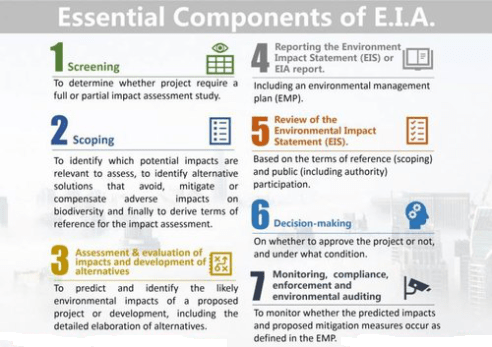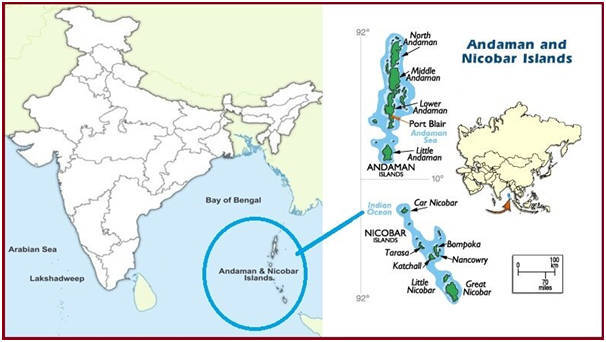Biodiversity & Environment
Development Project in the Great Nicobar Island: Inaccurate EIA
- 27 Jan 2022
- 7 min read
For Prelims: Great Nicobar Island, Environmental Impact Assessment, Galathea Bay, Giant Leatherback, Migratory birds, Onge tribe, Shompen Tribe, Campbell Bay.
For Mains: Environmental Impact Assessment, Development Project in the Great Nicobar Island and its impact on environment.
Why in News
The recently released draft Environment Impact Assessment (EIA) report for the mega development project in the Great Nicobar Island has raised serious questions related to submission of incorrect or incomplete information, scientific inaccuracy and failure to follow appropriate procedure.
- A committee of the Ministry of Environment Forest and Climate Change (MoEFCC) issued Terms of Reference (ToR) to prepare the EIA report in May 2021.
- Earlier, a plan for the sustainable and holistic development of the 680 sq km, fragile Little Andaman Island in the Andaman and Nicobar group had raised the alarm among conservationists.
Environmental Impact Assessment (EIA)
- It is a process of evaluating the likely environmental impacts of a proposed project or development, taking into account inter-related socio-economic, cultural and human-health impacts, both beneficial and adverse.
- EIA is statutorily backed by the Environment Protection Act, 1986 which contains various provisions on EIA methodology and process.
Key Points
- About:
- NITI Aayog-piloted Rs. 72,000-crore integrated project in Great Nicobar includes construction of a mega port, an airport complex, a township spread over 130 sq. km of pristine forest and a solar and gas-based power plant.
- Andaman and Nicobar Islands Integrated Development Corporation Ltd. (ANIIDCO) is the project proponent.
- Ecologists and researchers have been raising concerns about this project for over a year.
- Issues with the EIA Report:
- Incorrect or Incomplete Information:
- The area of the island is mentioned in one place as 1,045 sq. km, while it is 910 sq. km (the current official figure) in another.
- It was reported that the Galathea port area does not record any coral reefs, whereas the Zoological Survey of India (ZSI) study shows that the coral reef spread over 116 hectares in Galathea Bay.
- Galathea Bay is an iconic nesting site in India of the enigmatic Giant Leatherback, the world’s largest marine turtle—borne out by surveys done over three decades.
- 330 species of fauna are recorded in the island, while the same ZSI study puts the number at more than double at 695.
- The EIA says in another place no migratory birds have been reported from Great Nicobar, whereas it is well known that these islands are located along two globally significant bird flyways and more than 40 species of migratory birds have been recorded from Great Nicobar.
- Institutional Callousness:
- The EIA report was expected to have details of the project proponent’s (ANDICO) environmental policy such as its standard operating process, procedures for highlighting violation of environmental and forest norms and for ensuring compliance with environmental clearance conditions.
- The undertaking, issued by the Directorate of Tribal Welfare, the agency tasked with the primary job of securing the rights of the indigenous people on the islands.
- It first assures that “the right of the tribal shall be well protected and taken care of” and,
- Then goes on to conclude that “whenever any exemption from the existing regulations/policies/law of the land are required to be provided for the execution of the project, this Directorate will seek required exemptions(s) from the competent authority to that effect”.
- Incorrect or Incomplete Information:
- Issues Raised by Environmentalists:
- This project is likely to impact turtle and megapode nesting sites and coral reefs at the islands.
- Many reserved areas are expected to be de-notified for the project including land under Great Nicobar Biosphere Reserve and a tribal reserve.
- Close to 81.74% of the island is covered with national parks, reserves and forests.
- The project will have a direct impact on the biodiversity and cascading effects on the indigenous Onge tribe.
- The Onge are one of the tribes of India's Andaman Islands.
Great Nicobar
- About:
- Great Nicobar is the southernmost island of the Nicobar Islands Archipelago.
- It covers 1,03,870 hectares of unique and threatened tropical evergreen forest ecosystems.
- It is home to a very rich ecosystem, including 650 species of angiosperms, ferns, gymnosperms, bryophytes, among others.
- In terms of fauna, there are over 1800 species, some of which are endemic to this area.
- Ecological Characteristics:
- The Great Nicobar Biosphere Reserve harbours a wide spectrum of ecosystems comprising tropical wet evergreen forests, mountain ranges reaching a height of 642 m (Mt. Thullier) above sea level, and coastal plains.
- Tribe:
- The Mongoloid Shompen Tribe, about 200 in number, live in the forests of the biosphere reserve particularly along the rivers and streams.
- Another Mongoloid Tribe, Nicobarese, about 300 in number, used to live in settlements along the west coast.
- After the tsunami in 2004, which devastated their settlement on the western coast, they were relocated to Afra Bay in the North Coast and Campbell Bay.






